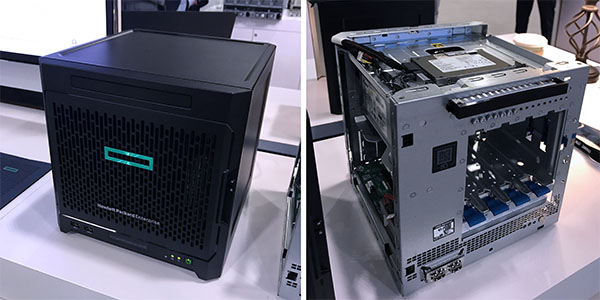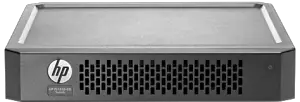HPE unveiled the ProLiant MicroServer Gen10 this week at HPE Discover and while a refresh was long overdue, the MicroServer has returned to its G7 roots with the new model. HPE decided never to release a Gen9 model of the MicroServer, though this Gen10 feels more Gen9 than new and shiny. The model notably returns to AMD processors, switches to a SoC motherboard, and also removes the iLO from the platform. The MicroServer was once touted for remote-office, branch-office use cases but the absence of IMPI, critical in ROBO, makes me wonder where this is targeted.
What’s Different and New?
The new MicroServer Gen10 features AMD processors, Opteron X3000 series with 2 core or 4 core as options and turbo clock speeds up to 3.4GHz. It scales up to 32GB, double the previous Gen8 model. The motherboard switches from a socketed Intel design to a System on a Chip design from AMD – meaning the processor cannot be field upgraded. The new motherboard design adds two PCI slots over 1 PCI slot in the previous Gen8 and G7 models.
For storage, 4 large form factor drive SATA slots are retained in the Gen10 model and the same limit of 4 x 4TB SATA drives in the drive slot. With SSD advancements, the new model adds the ability to replace the DVD drive with an SSD in a 5th slot near the top of the cube, but complicating things for OS installations with the absence of virtual media through iLO.
For video, the new model includes two display ports, possibly signaling the intended use case for the system around video applications – perhaps video walls and other things. Upgraded GPU capabilities also accompany the new model, but both of these trade-off mean that MicroServer is less of a general-use server and more specifically for uses where graphics are needed – so not home-lab users or general ROBO virtualization.
HP released the MicroServer Gen8 back in 2013/2014, with a strange cubical form factor and the new Gen10 model retains this design, in fact, allowing a Gen10 to stack on a Gen8 or vice versus. The bezel on the model now comes in a black finish instead of the default silver look of the Gen8.
HPE is also talking about ClearOS on the MicroServer Gen10. ClearOS is a linux distribution based on CentOS and Red Hat with a marketplace of application solutions from 6 categories: Cloud, Gateway, Server, Networking, System and Reports, according to the ClearOS website. HPE is touting it as a cost-effective alternative in the SMB market, and showed it off on the MicroServer Gen10 during HPE Discover.
Where does it miss?
With the introduction of Gen10, HPE is touting the security of their ProLiant servers – billing them as the ‘most secure industry standard server.’ With the MicroServer, the absence of iLO means the security features do not extend to the new MicroServer. The ‘silicon root of trust’ utilizes the iLO 5 silicon to establish that NIST compliant security, so even the inclusion of an iLO 4 would not have helped this capability.
The iLO inconsistency is not a first for HPE – a couple of the lower-end Gen8 models included iLO3 chips rather than the new iLO4 that shipped with Gen8. Some of the Gen9 models are missing an iLO all together. The compromise is certainly targeted towards bringing costs down, but its a trade off that I’m sad to see. Even the original MicroServer G7 model had the option of an remote console card in the PCI slot – a waste of a PCI slot in my opinion – but at least it had the option for anyone who found it important.
If HPE wants to follow a SoC motherboard model for this line, I hope to see a Xeon-D variant in the future. A socketed model is better, but with a wide support of the Intel SoC models, I hope that at least we get an option in the future.
I’ve used a ProLiant MicroServer Gen8 in my home lab for years. I sold it during my move, but it is truly one of the best home lab models I have found, mostly because I prefer a strong and capable IPMI. So, that’s why I think I’m taking the absence of iLO so hard in this new model. The community waited for a long time for this and the home lab options from SuperMicro are abundant, even with a sub-par IMPI interface.






 With this information, HP introduced the first Proliant MicroServers in 2010. Equipped with AMD Athalon N36L, N40L, and N54L processors as options, each unit could add up to 8TB of storage (4 x 2TB drives) and 8GB of DDR3 ECC RAM. It included 6 USB 2.0 ports, 1 eSATA port and 1 Gigabit Ethernet portand an optional remote management card akin to iLO. The first MicroServer was quiet, touting less than 21db of noise emitted and it ran on standard 110 power.
With this information, HP introduced the first Proliant MicroServers in 2010. Equipped with AMD Athalon N36L, N40L, and N54L processors as options, each unit could add up to 8TB of storage (4 x 2TB drives) and 8GB of DDR3 ECC RAM. It included 6 USB 2.0 ports, 1 eSATA port and 1 Gigabit Ethernet portand an optional remote management card akin to iLO. The first MicroServer was quiet, touting less than 21db of noise emitted and it ran on standard 110 power.

